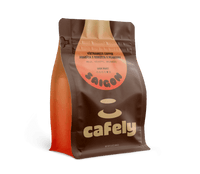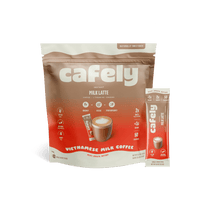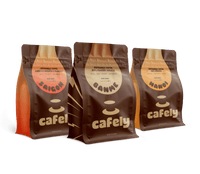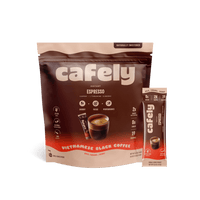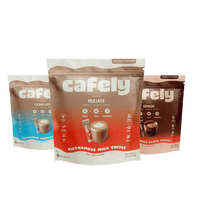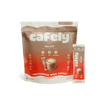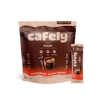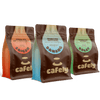Coffee extract is a key ingredient behind many of our favorite coffee-flavored recipes — from tiramisu to decadent espresso-flavored cocktails.
Unlike regular brewed coffee, extracts are a concentrated form designed for use in baking, mixing, and enhancing dishes and drinks without watering them down.
Whether you’re the home baker, cocktail enthusiast, or just someone who loves experimenting with the flavor of coffee, understanding this intriguing extract opens up a world of culinary possibilities.
In this guide, you’ll learn what coffee extract is, how it’s made, what it tastes like, and how you can use (and make) it yourself…
What is Coffee Extract?

Coffee extract is a highly concentrated liquid made by steeping ground coffee beans in alcohol to pull out their flavor compounds and aromatic oils.
Unlike coffee concentrate — which is meant for brewing iced coffee and other beverages — coffee extract is primarily used as a flavoring agent, similar to vanilla extract.
Coffee extract packs a deep, intense coffee flavor that’s much stronger than any brewed coffee — no matter how concentrated. This makes it perfect for making recipes where you want the taste of coffee without adding volume or watering down the flavor of the dessert, baked good, or drink.
How is Coffee Extract Made?
Coffee extract is typically made by soaking ground, roasted coffee beans in a high-proof, neutral alcohol.
The alcohol draws out flavor compounds and aromatic oils over a period of weeks. This results in a dark, aromatic, highly concentrated liquid.
The goal is to capture the full depth of coffee’s flavor in a concentrated liquid form that can be stored and used over time without brewing a fresh cup.
Step 1: Bean Selection
The process begins with selecting high-quality, freshly roasted coffee beans. The choice of beans plays a major role in the flavor profile of the extract — for example, a fruity
Ethiopian arabica bean will give a very different result compared to a bold, dark, Vietnamese robusta coffee.
Step 2: Grinding
Once you’ve chosen the right beans, they must be ground to expose more surface area to the alcohol.
A coarse grind is ideal because it allows for efficient flavor extraction while preventing too many fine particles from clouding the liquid. The grind size also influences the intensity and clarity of the final extract.
Step 3: Alcohol Extraction
After grinding the coffee, it must be submerged in high-proof alcohol and left to steep for several weeks to extract the flavor compounds from the coffee.
The coffee and alcohol mixture is allowed to steep for anywhere from 1 to 4 weeks, with occasional shaking to redistribute the grounds and ensure even extraction.
Over time, the alcohol absorbs the coffee’s color, aroma, and complex flavor compounds, turning into a dark, richly scented liquid.
Step 4: Straining
Once the extraction period is complete, the liquid is strained through a fine filter to remove the grounds, leaving a smooth, clean coffee extract behind.
This extract can then be bottled and stored in a cool, dark place for 12 to 24 months.
What Coffee Extract Tastes Like
Coffee extract delivers a strong, concentrated, roasted coffee flavor that’s slightly bitter but far more aromatic than regular brewed coffee.
The taste can vary depending on the coffee used to make it. Arabica produces a smoother extract with floral, fruity, nutty undertones.
Robusta coffee produces a dark, bold, strong extract with a high level of bitterness. Blends create an extract that portrays the qualities of both arabica and robusta.
Darker roasts create extracts with notes of caramel, nuts, and chocolate, while lighter roasts create extracts with floral, fruity undertones. Medium roast beans produce extracts that balance deep, caramelized notes with light, fruity, and tropical flavors.
What is Coffee Extract Used For?

Coffee extract is incredibly versatile. It can be used in both sweet and savory applications, from simple savory baked goods to sweet, decadent desserts.
Here are some common uses for coffee extracts:
1. Baking Desserts
Coffee extract is a simple way to add depth to sweet recipes. Just a teaspoon or two can turn chocolate cake or brownies into mocha-flavored masterpieces, or give cheesecake a subtle roasted edge.
Because it adds flavor without extra liquid, extract works in delicate bakes like macarons, sponge cakes, or cookies where brewed coffee would throw off the texture. It’s also ideal for tiramisu — mixed into the cream filling or diluted to soak ladyfingers, ensuring a bold, consistent coffee taste throughout.
Even lighter pastries and cookies benefit from a touch of coffee extract, especially when paired with chocolate or caramel.
2. Flavoring Drinks
One of the most popular uses for coffee extract is in beverages. For coffee-based drinks — especially cocktails — coffee extract can enhance flavor without needing to brew coffee or dilute other elements of the drinks.
Even in other drinks such as milkshakes, smoothies, and hot cocoa, coffee extract introduces a subtle bitterness that complements, balances, and adds sweetness and complexity to the drink.
In cocktails, coffee extract can replace brewed coffee in classics such as the espresso martini, white Russian, and coffee-infusioned old-fashioned. Unlike brewed coffee, which can dilute a drink, coffee extract packs concentrated flavor into just a few drops — perfect for the amateur mixologist.
You can even stir a bit into sparkling water with a sweetener for a refreshing coffee soda.
3. Ice Creams & Gelato
Coffee extract is often used to make coffee-flavored iced creams and gelato. These timeless classics are easy to make with a well-balanced extract.
To make coffee ice cream or gelato with coffee extract, simply add the extract to your ice cream or gelato base before churning. Then, freeze the mixture as normal for a coffee-infused frozen delight.
This method works perfectly when you want a creamy texture without ice crystals — something brewed coffee often causes due to its water content.
4. Savory Marinades
While coffee extract is most commonly associated with sweets, it can be an unexpected star in savory cooking. Adding a small amount to marinades for beef, pork, or even poultry can deepen flavors, especially in barbecue or smoked dishes. The roasted, slightly bitter notes complement spice rubs and help create a rich, caramelized crust when the meat is seared or grilled.
It works especially well in mole sauces, chili, or beef stews, where layered flavors are key. When used in moderation, coffee extract won’t make a dish taste like coffee — instead, it enhances umami and balances sweetness in sauces and glazes.
5. Homemade Syrups
Coffee extract can be combined with sugar and water before heating gently over a low to medium heat to create a quick, flavorful coffee syrup that’s perfect for drizzling over pancakes, waffles, and other quick desserts.
The syrup can also be added to cold brew, iced coffee, and coffee cocktails for an intense and instant coffee-flavored kick without the need for brewing.
6. Chocolates & Confections
Coffee and chocolate are a flavor pairing made in heaven, and coffee extract brings out the best in both. Chocolate makers often add a touch of high-quality coffee extract to truffles, fudge, and flaked chocolate to intensify cocoa’s natural nutty, bitter flavors.
The slight bitterness of coffee extract helps balance the sweetness of confections, creating a more refined taste.
You can also incorporate coffee extract into candy recipes, from caramels to marshmallows, for a gourmet twist. Even a small amount can elevate a simple chocolate ganache, making it perfect for filling pastries or dipping fruits.
How to Make Coffee Extract at Home
Coffee extract is surprisingly easy to make at home. You only need a couple of ingredients and a few pieces of equipment you'll likely have in your kitchen.
Here's how to make coffee extract at home:
Ingredients:
- High-Quality Coffee — Opt for a high-quality, whole-bean coffee that’s freshly roasted and grind it fresh before extraction.
- High-Proof Alcohol — Select a high-proof, neutral alcohol such as vodka. Make sure the alcohol has no flavor, to ensure the coffee flavor shines through in the extract.
Equipment:
- Coffee Grinder — You’ll need a burr or blade grinder to increase the surface area of your beans for more efficient extraction.
- Weighing Scale — Use a weighing scale to portion the coffee consistently every time you make an extract.
- Airtight Glass Jar — You’ll need an airtight glass jar for storing the coffee and alcohol mixture during extraction.
- Fine Mesh Sieve — Use a fine mesh sieve to separate the coffee grounds from the infused liquid after extraction.
- Funnel — A funnel is needed to syphon the extract into containers for storage.
- Storage Jar — Use a series of dark, glass bottles or jars for long-term storage.
Coffee Recommendations:
The type of coffee you use to make your extract will significantly affect its flavor profile. Whether you choose arabica, robusta, or a blend of both beans will dramatically affect the taste of your coffee extract.
- Arabica Coffee — Choose a 100% arabica coffee such as Cafely DaLat if you want smooth, mild, nuanced flavors in your coffee extract.
- Robusta Coffee — Choose a 100% robusta coffee such as Cafely HaNoi if you want a dark, bold, strong coffee extract.
- Blends — Choose a well-balanced blend of robusta and arabica, such as Saigon OG, if you want to create a coffee extract with the characteristics of both beans.
1. Select & Grind the Coffee
Start by selecting your beans. Opt for a high-quality, whole-bean coffee from a reputable supplier for the best quality coffee extract.
Grind the beans to a coarse consistency — similar in texture to kosher salt. This maximizes surface area without creating too many fines, which can cloud and thicken the extract after filtration. If you grind too finely, you’ll also extract more bitterness from the coffee.
Use a burr grinder for the most consistent results.
2. Combine the Coffee and Alcohol
In an airtight glass jar, add the ground coffee and alcohol. Use a 1:2 ratio — one cup of coarsely ground coffee to two cups of alcohol.
Start by placing the ground coffee in your jar before pouring in the alcohol.
Stir gently to combine the grounds.
3. Seal and Store
Seal the jar tightly and place it in a cool, dark spot (such as a pantry or cupboard). Light and heat can degrade flavor, so avoid sunny kitchen counters.
4. Allow to Steep
Let the mixture infuse for at least one week, but for a richer extract, allow it to steep up to four weeks. Shake the jar gently every few days to redistribute the coffee grounds and promote even extraction.
5. Strain the Extract
Once the desired “brewing” time has passed, strain the liquid through a fine mesh sieve lined with a cheesecloth or paper coffee filter.
This step removes the coffee grounds from the infused liquid, leaving a clean, smooth extract behind.
6. Bottle and Store
Use a funnel to transfer the filtered extract into sterilized dark glass bottles or jars. Store in a cool, dark place.
Properly made coffee extract can last up to 2 years thanks to the preservative power of alcohol, but for peak flavor, aim to use it within 12 to 18 months.
FAQs: What is Coffee Extract?

Want to learn more about coffee extract?
Check out the answers to the frequently asked questions below…
1. What Are the Ingredients in Coffee Extract?
Coffee extract is typically made by soaking roasted coffee beans in a solvent — usually alcohol. This draws out the flavor and aroma from the coffee. Some commercially available “coffee extracts” may also contain sugar, water, and flavor stabilizers.
2. How Is Coffee Extract Made?
Coffee extract is produced by soaking roasted and ground coffee beans in a solvent (usually alcohol) for an extended period before filtering the organic matter. This process extracts the natural oils, caffeine, flavors, and aromatic compounds from the beans, creating a concentrated liquid.
3. Is Coffee Extract the Same as Coffee Concentrate?
No. Coffee extract is a flavoring made for culinary use in desserts and beverages. Coffee concentrate is essentially brewed coffee that’s made with less water. Concentrated coffee is typically used to make iced beverages, while extract is used to flavor desserts and drinks.
4. What Does Coffee Extract Taste Like?
Coffee extract has a deep, robust coffee flavor. On its own, it’s bitter, overpowering, and much more intense than brewed coffee. However, when diluted or used in baking, it adds a rich, nutty, roasted flavor to the food.
5. How Much Caffeine in Coffee Extract?
The caffeine content in coffee extract varies depending on the type of bean and the extraction method used. Coffee extract contains more caffeine per mL than brewed coffee, but less per serving due to the small amount used to make food and drinks.
6. What’s the Difference Between Coffee Extract and Espresso?
Espresso is a beverage made by forcing pressurized hot water through finely ground coffee. The result is a concentrated brew that can be consumed as a shot or as part of a milky brew — latte, cappuccino, mocha, etc. On the other hand, coffee extract is not brewed to drink — it’s a concentrated flavoring made by steeping coffee grounds in alcohol.
7. How Long Does Coffee Extract Last?
When stored correctly — in a cool, dark place — unopened coffee extract can last for decades. Once open, it maintains quality for one to two years before the taste and aroma begin to degrade.
8. Is Coffee Extract Natural or Artificial?
It can be either — natural coffee extract is made from real coffee beans, whereas artificial versions use synthetic flavors and aromatics to mimic the taste of coffee. Always check the label if you buy coffee extract from the store.
9. Can Coffee Extract Be Used in Drinks?
Yes. Coffee extract can be added to cocktails, milkshakes, smoothies, or lattes to give a strong coffee flavor without brewing coffee.
10. Does Coffee Extract Contain Sugar?
Pure coffee extract doesn’t contain any sugar — it’s just a solvent-based extract made from coffee beans. However, some brands may sweeten their products with sugars and flavors. Always check the ingredient list before consuming to be sure.
